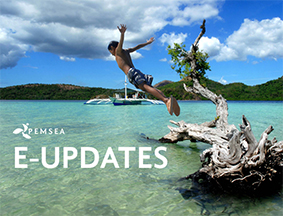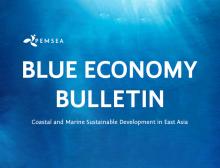
Breadcrumb
-
PEMSEA E-Update January 2018
Welcome to the first edition of the e-Update for 2018! PEMSEA kicks off its 25th anniversary year by welcoming a new Executive Director, Aimee Gonzales. 2018 promises to be a full year as PEMSEA reflects on the successes and lessons of two-and-a-half decades of partnerships for healthy oceans, people and economies in the the East Asian Seas, and sets its sights on the next 25 years.
Follow us on Facebook and Twitter (@PEMSEA) for the latest updates.
-
Blue Economy Bulletin December 2017
Welcome to the final issue of the Blue Economy Bulletin for 2017! Thank you for your continued interest in blue economy news and events in East Asia and around the world.
Wrapping up a busy year for PEMSEA, the province of Cavite in the Philippines launched its State of the Coasts Report. In Bangkok, experts from both the public and private sectors participated in PEMSEA’s Blue Economy Forum to discuss the state of ocean health and blue economy growth in the region. Meanwhile, local capacity building continues to advance through PEMSEA’s Traineeship Programme, which included topics on blue economy and investment. Under the PEMSEA Blue Economy Webinar series, Dr. Jenna Jambeck presented on tackling ocean plastic waste in the seas of East Asia.
As the urgency to address plastic pollution increases, research continues to emerge on the impact of the problem, for instance, a report showing that some fish are attracted to plastic particles covered in algae, mistaking these for food. Experts continue to develop new solutions to manage plastic waste as the critical role of the private sector in marine protection becomes even more apparent. In sustainable finance, Fiji has successfully issued a green bond to boost climate resilience. Clarmondial and WWF release a new report on how conservation organizations can better mobilize private investment for positive environmental results. Discussions at the COP 23 highlighted the link between oceans and climate change.
2018 will be an exciting year, marking PEMSEA’s 25th anniversary and the triennial East Asian Seas Congress! We look forward to stronger partnerships as we work together towards the sustainable development of our shared seas.
Follow the latest updates on blue economy and coastal sustainable development in East Asia on Facebook and Twitter (@PEMSEA). We welcome your feedback, and please let us know if there are other blue economy topics you would like to see in future newsletters and programs.
-
PEMSEA E-Update October 2017
Welcome back to PEMSEA's E-Update, your source for the latest information on PEMSEA’s activities and news and events relevant to sustainable development of coasts and oceans in East Asia.
PEMSEA is getting ready for the Blue Economy Forum in Bangkok, Thailand, to highlight the value of blue economy growth in the region. Check out this infographic to understand how industries are dependent on healthy oceans. PEMSEA officially joined the International Partnership for Blue Carbon to advance awareness of the value of blue carbon for oceans and climate. With its practical solution to address one source of plastic pollution in our seas, Sip PH was announced as the winner of PEMSEA's Youth Small Grant for 2017.
In between newsletters, follow us on Facebook and Twitter (@PEMSEA) for the latest updates.
-
Blue Economy Bulletin October 2017
Welcome to the latest edition of the Blue Economy Bulletin! In the past few weeks, PEMSEA has been busy with several activities, the most exciting of which is the announcement of a new Executive Director, Ms. Aimee Gonzales, who will assume her role starting in 2018. Highlighting the latest research on “blue carbon” in the region, PEMSEA hosted a webinar featuring international blue carbon experts. During the recent US-ASEAN Conference on Marine Environmental Issues, PEMSEA participated in a blue economy panel along with Minister Kobkarn Suriyasat Wattanavrangkul, Thailand’s Minister of Tourism and Sports.
Countries in the region continue to strengthen their programs for coastal management and blue economy. PEMSEA is a proud partner of the Yellow Sea Large Marine Ecosystem (YSLME) Project Phase II, which is taking major steps forward. In Vietnam, the national government defines its master plan for the seas, BRICS countries emphasize the growth opportunities in blue economy and China’s government develops Qingdao for blue economy growth. On the industry side, hotels and marine industries in Thailand unite to focus on marine environmental issues, while a coalition of companies join forces to build a blockchain-based marine insurance platform.
Follow the latest updates on blue economy and coastal sustainable development in East Asia on Facebook and Twitter (@PEMSEA). We welcome your feedback, and please let us know if there are other blue economy topics you would like to see in future newsletters and programs.
-
PEMSEA E-Update September 2017
Welcome to the second edition of PEMSEA’s re-launched E-Update! We’re excited to introduce a new look and format, supported by an improved platform for managing updates to the PEMSEA community. The E-Update will arrive in your email every other month with the latest information on PEMSEA’s activities and news and events relevant to sustainable development of coasts and oceans in the region. In alternate months, you’ll receive the PEMSEA Blue Economy Bulletin, with updates on industry, investment and other topics relevant to blue economy development. In between newsletters, follow us on Facebook and Twitter (@PEMSEA) for the latest updates.
-
Blue Economy Bulletin July 2017
Welcome to the mid-summer edition of the Blue Economy Bulletin! You may notice some changes with the bulletin starting this month. PEMSEA re-launched its regular e-update last month, which will focus on policy, governance, science and coastal management in the Seas of East Asia. The Blue Economy Bulletin will now focus even more on sustainable economy, industry, technology, financing and investment in the region. Look to receive the PEMSEA e-update and Blue Economy Bulletin in alternating months.
Since the last issue, China continues to build its plans for blue economy, while the Philippines takes steps to green the shorelines of its largest economic center. Consumer goods companies may think twice about their contribution to ocean pollution, while the largest tuna company in the world adopts more sustainable practices. The shipping sector also finds itself under pressure to reduce its carbon emissions.
Follow the latest updates on blue economy and coastal sustainable development in East Asia on Facebook and Twitter (@PEMSEA). We welcome your feedback, and please let us know if there are other blue economy topics you would like to see in future newsletters and programs.
-
PEMSEA E-Update July 2017
PEMSEA Hosts Side Event On "Catalyzing Investments In SDG 14: Establishment Of A Strategic Ocean Investment Ecosystem" At United Nations Ocean Conference
Thousands of delegates from around the world converged on United Nations headquarters in New York City from June 5 - 9 for the UN Ocean Conference supporting implementation of SDG 14. PEMSEA partnered with UNDP, UNEP, The Economist, Credit Suisse and others to host a discussion on the need for innovative financial mechanisms to drive the transition to more sustainable blue economies and establishing a regional Ocean Investment Facility and Funds. PEMSEA was honored to have Mr. Peter Thomson, President of the General Assembly of the United Nations, deliver opening comments for the event.
-
Blue Economy Bulletin April 2017
2017 is an important year for oceans, with the United Nations Ocean Conference planned for June 5-9 in New York City. PEMSEA will be participating in the conference, and earlier this month we were pleased to submit our commitment to supporting SDG 14. We are also excited to highlight a new partnership with R20 Regions of Climate Action on low-carbon, blue economy investment in the region. PEMSEA continues its work on an evidence-based approach to blue economy in the region, and we hosted a webinar on optimizing social media for marine biodiversity conservation.
Countries including China and Indonesia continue taking concrete steps to protect the health of their coasts and oceans. In the private sector, the launch of a new tool for sharing ESG data promises to provide more transparency into companies’ responsible practices. Reports state that investments in conservation have increased, but marine protected areas still lack funding. At the same time, the World Resources Institute released a useful mapping of climate finance architecture.
Follow the latest updates on blue economy and coastal sustainable development in East Asia on Facebook and Twitter (@PEMSEA). We welcome your feedback, and please let us know if there are other blue economy topics you would like to see in future newsletters and programs.
-
Blue Economy Bulletin February 2017
Welcome to the first issue of the Blue Economy Bulletin for 2017! To begin the year, please help us continue to improve our delivery of relevant blue economy updates by answering this short survey (less than 5 minutes).
Kicking off 2017, PEMSEA hosted a webinar in partnership with Conservation International on how the ocean’s health is being measured. A recording is available online.
We start the year with good examples of progress on coastal and ocean sustainable development. Stanford scientists found proof that large marine protected areas create positive impacts on reef shark populations and UC Santa Barbara partnered with global leaders to help secure the future of the oceans. In Central Java, a restored mangrove forest generates ecotourism revenue for a local community.
Governments all over the world are strengthening their policies and enforcement on coasts and oceans. In East Asia, Vietnam announced its marine plans, Indonesia revealed its desire to crack down on fish aggregating devices, China committed to ocean economy demonstration zones and the Philippines strengthened its protection of a marine biodiversity hotspot. In Europe, countries are pushing for increased transparency in fisheries outside the EU.
Innovations such as blockchain technology, breakthrough methods of recycling ocean plastic and sustainable aquaculture feed offer examples of some of the new technologies and practices that can help solve some of our most pressing ocean issues. Organizations continue to push the boundaries of conservation finance with a new report from Forest Trends’ Ecosystem Marketplace on private capital invested towards environmental conservation, and leading global banks launching a framework aimed at channeling investments towards achieving the UN SDGs. Read on for more.
Follow the latest updates on blue economy and coastal sustainable development in East Asia on Facebook and Twitter at @PEMSEA. We welcome your feedback.

